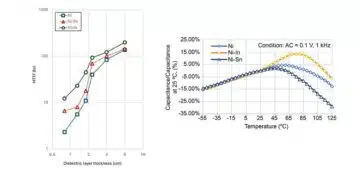TDK Corporation announces the release of five new eco-friendly SMD multilayer varistors (MLVs).
As an industry first, these components feature a reduced carbon (CO2) footprint while fulfilling demanding automotive qualification requirements.
These parts are the first representatives of TDK’s new X-series, which is continually being expanded for automotive as well as for industrial and consumer applications. The X series satisfies both the growing demand for eco-friendly products, and the commercial requirement for cost-attractive products, while maintaining TDK’s high level of reliability and performance.
The first five parts are automotive qualified according to AEC-Q200, a feature which can be recognized by a “1” following the “X” in the part number. They are generally used to protect a vehicle’s engine management system, electronic control units (ECUs), airbags, ABS, ESP, etc. against transient overvoltages on the battery lines resulting from events such as load dump and jump start.
These components provide ESD protection up to 30 kV according to IEC 61000-4-2 and comply with automotive pulses according to ISO 7637-2/16750-2.
Available in four EIA package sizes (0603, 0805, 1206, and 1210), the new components support maximum RMS operating voltages of 14 V, 25 V, and 30 V respectively, with response times to voltage transients ranging from 10 ps to 500 ps. They handle surge currents from 5 A to 400 A for 8/20 µs pulses, while maintaining a leakage current of just 1 µA to 25 µA at the rated DC voltage and room temperature. Their operating temperature spans from -55 °C to +150 °C without derating, even at higher temperatures.
The X-series is being further expanded to a comprehensive range of overvoltage protection components, also for industrial and consumer applications. Simulation models for PSpice are available.
Features
- Reliable ESD protection up to 30 kV according to IEC 61000-4-2
- Comply with automotive pulses according to ISO 7637-2/16750-2
- Load-dump and jump-start protection
- Low leakage current
- Qualified based on AEC-Q200 (X1-Series)
- No temperature derating up to +125 °C (X1-series up to +150 °C)
- High lifetime robustness
- Stable protection level
Applications
Transient overvoltage protection for:
- Automotive battery lines
- Engine management systems
- Electronic control units (ECUs)
- Airbag, ABS, ESP, etc
| Ordering Code | Maximum RMS operating voltage VRMS [V] | Varistor voltage VV (1 mA, +25 °C) | Maximum surge current Isurge,max [A] (8/20 μs) | Dimensions (L x W x H) [mm] |
|---|---|---|---|---|
| B72500X1250L060 | 25 | 51.9 … 70.1 | 5 | 1.6 x 0.8 x 0.9 |
| B72510X1140S162 | 14 | 22.0 … 27.0 | 120 | 2.0 x 1.25 x 1.4 |
| B72520X1300K062 | 30 | 42.3 … 51.7 | 200 | 3.2 x 1.6 x 1.7 |
| B72530X1140S162 | 14 | 22.0 … 27.0 | 400 | 3.2 x 2.5 x 1.7 |
| B72530X1250K062 | 25 | 35.1 … 42.9 | 300 | 3.2 x 2.5 x 1.7 |































